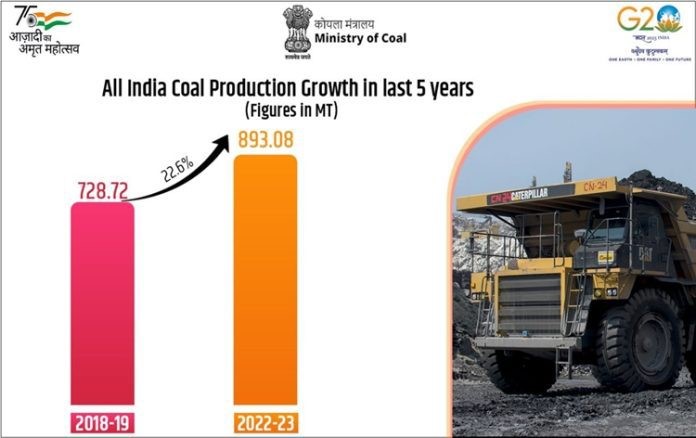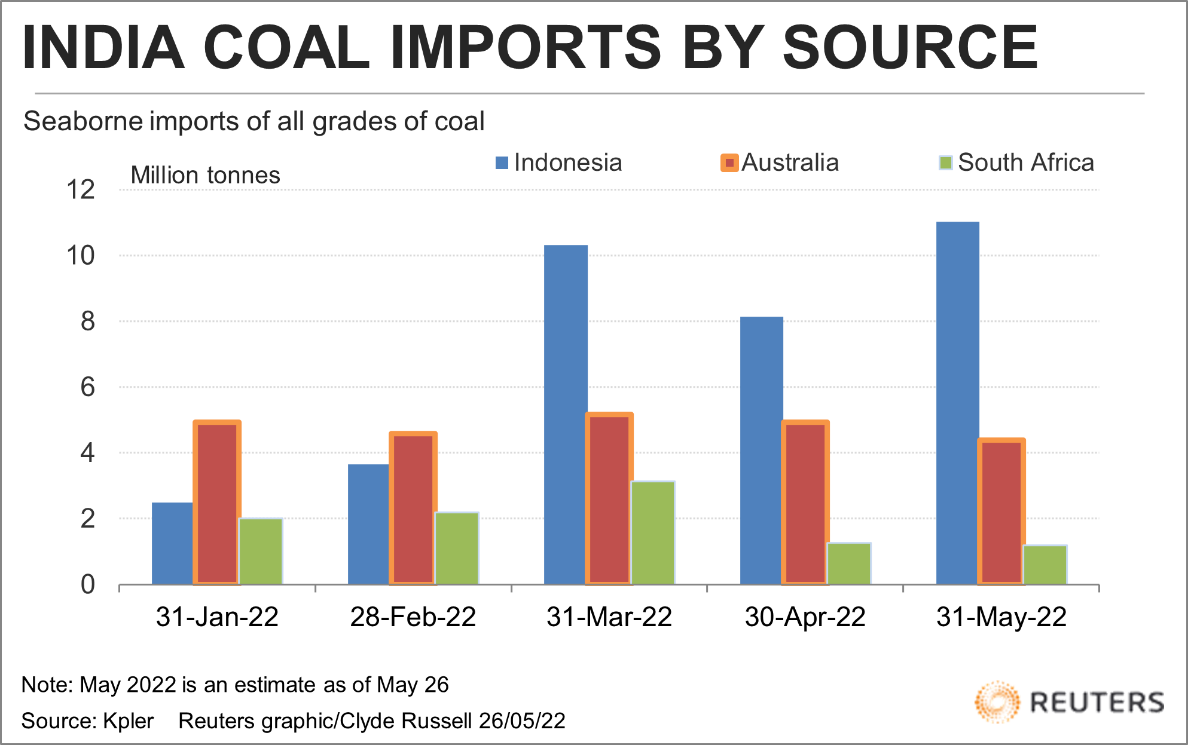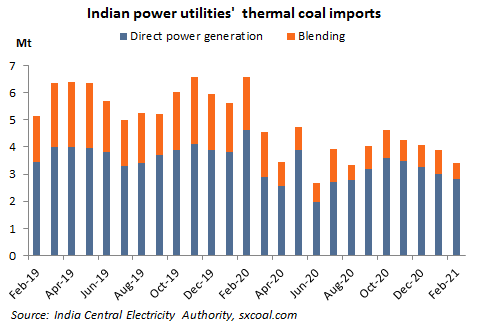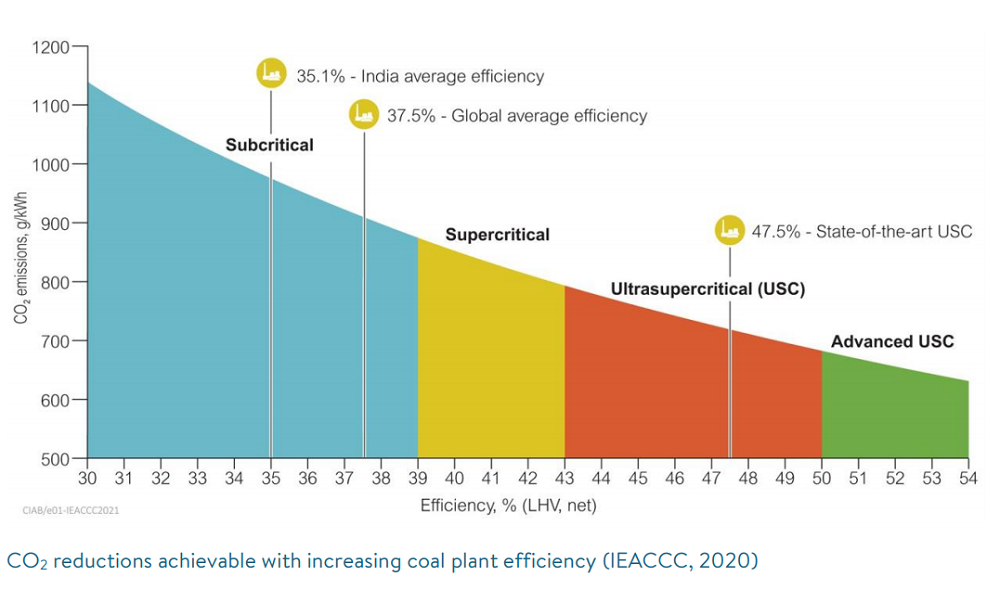SPOTLIGHT| INDIA'S DEPENDENCE ON COAL IMPORT
Context
- The Energy Expert underlined that India's dependence on import of natural gas and oil is high but it has reduced for coal.
Details:
- The aim of the national action plan of the Government of India is to produce around 1.5 Billion Tons of coal by 2030.
- "Dependence on imports for coal has come down by roughly 24 to 25%."
- In 2020, the import was around 248 MT from overseas. The import was mainly from South Africa, Indonesia, Namibia, Australia, and New Zealand but now the import has reduced to around 186 MT.
|
- New technologies and methods, efficient training, and management have also led to a boost in coal production.
- The Government is taking various other initiatives to reduce import dependency.
- According to the expert, per capita energy consumption is also increasing as almost all the villages in India are electrified. Therefore, demand for coal is going up for domestic production of electricity.
- Seamless transportation of coal across the country: India's coal areas are mainly located in the eastern part of the country and some in central India.
- But the industries and population are spread all across the country. Railways play an important role in ensuring seamless transportation of coal.
- The Energy Expert mentioned that during monsoon season, rail transport is disrupted.
- Hence, to make sure that coal is available 24x7 for 12 months, the Government of India has developed dedicated rail corridors.

Coal imports and production:
The value of India’s coal imports have risen by 38.2% to Rs.1,38,477 crore in 2017-18. However, the quantity of coal imports has increased only by 9.1% from 190.95MT to 208.27MT during this period.
The increase in value of coal imports is primarily due to:
- Increase in international coal price leading to greater value increase as compared to absolute quantity increase in 2017-18.
- Increase in value of imported coking coal. India is deficient in coking coal and as such imports of coking coal are inevitable. In 2017-18 the value of imported coking coal grew by 44%, from Rs. 41,230.06 crores to Rs.59,522.63 crores.
- Many thermal power station are configured to use imported coal. As such imports by these thermal power plants are inevitable.
- During April-October 2018, these power plants have imported 22.27 MT of coal.
- The imported quantity of 2017-18 at 208.27 MT is less than the imported quantity of 2014-15 which stood at 217.79 MT even as power generation and industrial activity grew substantially after 2014-15.
- There has been a consistent effort to increase domestic coal production so as to reduce dependence on coal imports. The all-India raw coal production has increased from 77 MT in 2013-14 to 676.48 MT in 2017-18.
- Absolute increase in all India coal production from 2013-14 to 2017-18 (four years) is 110.71 MT as compared to increase of coal production of 33.73 MT from 2009-10 to 2013-14 (four years).
- Coal India Limited (CIL) has also increased its production from 462.41 MT in 2013-14 to 567.36 MT in 2017-18 (four years), an absolute increase of 105 MT as compared to increase of coal production of 31.15 MT between 2009-10 and 2013-14 (four years).
Why does India import coal when it has enough?
- India does not have enough reserves of good quality coal especially coking coal that is used as a raw material in steel making and allied industries.
- Most of it is imported from Indonesia, South Africa, Russia and Australia.
- Thus, the imports are mainly to compensate the lack of good quality coal, especially coking coal.
- Plus, there is a gap between demand and domestic production capacity.
- In FY19, the country produced around 730 mt of coal, while the consumption was close to 965-970 mt.
India’s coal imports and exports:

- India’s coal imports have more than tripled in the last decade, reaching 248.54 million tonnes (both coking coal and non-coking coal combined) in 2020-21.
- Ministry of Coal datashows that the comparable figure for 2010-11 was just 68.92 million tonnes.
- In the country, coal can be freely imported under open general licence.
- India is the second largest coal importer in the world and it imports mainly from Indonesia, Australia, South Africa and the United States.
- On the other hand, exports have only fallen during the period. In 2010-11, India exported over 2 million tonnes of coal while in 2020-21 the figure fell below 1 million tonne.
- In comparison to imports, the export of coal from India is paltry. Indian coal is mainly exported to Nepal, Bangladesh and Bhutan.
- India raised its overall production to 716.08 million tonnes in 2020-21 owing to sustained programme of investment and greater thrust on application of modern technologies.
- Meanwhile, Coal India Limited (CIL) and its subsidiaries accounted for 622.640 million tonnes of the output during 2021-22 compared with a production of 596.219 million tonnes in 2010-11 recording a robust growth.
READ: https://www.iasgyan.in/blogs/coal-sector

Who imports coal in India?
- India’s coal resources are found in older Gondwana Formations of peninsular India and younger tertiary formations of north-eastern region.
- However, to meet demand, India imports two types of coal, coking and non-coking coal.
- Coking coal is being imported by Steel Authority of India Ltd (SAIL) and other steel manufacturers. This is done to bridge the gap between the requirement and domestic availability and to improve the quality.
- Non-coking coal is imported by coal-based power plants, cement plants, captive power plants, sponge iron plants, industrial consumers and coal traders.
- Coke is imported mainly by pig-iron manufacturers and iron & steel sector consumers using mini-blast furnaces.
- While electricity sector is the largest consumer of coal, cement industry, steel and washery industry and fertiliser and chemical industry also require coal supplies.
What ails Indian coal industry?
- Due to extreme weather conditions this year (India witnessed an unprecedented heatwave this year), the demand for electricity also surged, leading to a coal shortage.
- This, coupled with a workers’ strike, could have a dampening effect on the coal industry that is unlikely to meet the domestic demand.
- Industries may be forced to import more this year. Workers are currently seeking a 47% increase in wages, a slight comedown from their earlier demand of a 50%. Coal India has offered a 3% raise.
- A group of unions is now currently hoping for an intervention by coal minister Pralhad Joshi who has been urged by both the sides to help conclude negotiations.
- For Coal India, the strike has struck at a time when it is already under pressure to boost output as India faces rising demand due to the post-pandemic economic recovery and scorching summer heat.
- Coal India is responsible for 80% of the domestic output.
- The high costs of coal imports are no help either as the world continues to face the heat of the ongoing war between Russia and Ukraine which has led to skyrocketing fuel prices and seaborne prices are also trading at record levels.
- Rising cost of fuel prices is stoking inflation and pushing down rupee, depleting the government finances.
India’s international commitments to reduce coal usage

- During the Paris talks in 2015, India had given three commitments towards reducing climate change. This included reducing the carbon intensity of its GDP (emissions per unit of GDP) by 33-35% by 2030, over what it was in 2005.
- 40% of its electricity generation capacity would be of non-fossil fuels by 2030.
- It would create carbon sinks that will aid in absorbing 2-3 billion tonnes of carbon dioxide by 2030.
- Prime Minister announced enhancements in these pledges and two of these has a major consequence towards coal usage.
- The first is that India’s non-fossil fuel capacity would reach 500 GW by 2030. This means that India’s non-coal, non-natural-gas-based power capacity should increase at least three-fold in nine years.
- Secondly, the announcement that India will get 50% of energy from renewable sources by 2030 cannot be achieved until a major pushback is done on coal.
- But in a country which generates more than half of its electricity by coal, fulfilling these announcements looks like a dream for now.
Resolving coal crisis
- In the current financial year (2022-23), the government expects to cut imports of coal (coking and non-coking) by around 35-40 million tonnes to around 180-190 million tonnes in FY-22.
- The government admits that there is a need for raising coal production as the country’s coal demand is expected to double by 2040 with the rise in electric vehicles and higher power demand for domestic consumption.
- Union Coal Minister announced plans to make the country self-reliant in the sector. Towards that end, the ministry points at extractable reserve in the closed/discontinued coal mines which is pegged around 380 million tonnes.
- India has the third-largest coal reserves in the world which is enough to last for the next 400 years at current consumption levels.
- However, there are several issues that need to be resolved before the country can reach its full potential in the sector.
- For one, Coal India enjoyed a long monopoly over the market and had little incentive to become efficient or market savvy to meet the demand.
- While the government had opened the gates for foreign players, lack of rail links to mines causes enormous disruption in supply of coal. The government needs to address this bottleneck on a war footing.
- Further, Indian coal is inferior in quality as it has high ash content rendering it almost unusable for sectors such as cement which has over the years preferred to import, and more recently shifted to pet coke.
- The government must also look at deploying the latest technology in mining to maximise the extraction process.
READ: https://www.iasgyan.in/daily-current-affairs/coal-production-in-india
https://newsonair.gov.in/News?title=India%26%2339%3bs-dependence-on-coal-import-is-going-down-rapidly%3a-Energy-Expert&id=46059
.jpeg)
NEWS IN SHORT
CYCLONIC CIRCULATION
Context
- Low-pressure area formed over Southeast Bay of Bengal, adjoining South Andaman Sea likely to intensify into cyclone by 10th May.
Details:
- The cyclonic circulation which developed two days back over the southeast Bay of Bengal will continue to move and intensify gradually into a cyclonic storm by Wednesday.
- A low-pressure area has formed over the southeast Bay of Bengal and adjoining south Andaman Sea today and it is likely to intensify into a depression tomorrow over the same region.
- A cyclonic storm will move towards the central part of the Bay of Bengal, and by the 12th of May morning, it will be over the central part of East Central Bay of Bengal.
- It is expected that it will become a very severe cyclonic storm over the central Bay of Bengal and it will change its path from the 12th of May onwards.
About Cyclonic Circulation
- Cyclonic rotation, or cyclonic circulation, is atmospheric motion in the same direction as a planet's rotation, as opposed to anticyclonic rotation.
- For Earth, the Coriolis effect causes cyclonic rotation to be in a counter clockwise direction in the Northern Hemisphere and clockwise in the Southern Hemisphere.
- A closed area of winds rotating cyclonically is known as a cyclone.
READ: https://www.iasgyan.in/blogs/cyclone-burevi-all-about-tropical-cyclones
https://newsonair.gov.in/News?title=Low-pressure-area-formed-over-Southeast-Bay-of-Bengal%2c-adjoining-South-Andaman-Sea-likely-to-intensify-into-cyclone-by-10th-May&id=460572

WORLD ATHLETICS DAY 2023
Context
- World Athletics Day 2023 was celebrated on 7th MAY.
Details:
- The International Association of Athletics Federations, or IAAF, introduced the World Athletics Day to promote athletics and inspire young people to participate in sports.
Objective:
- The main objective of this day is to raise awareness about fitness among children and encourage young and school children to take up athletics.
Theme
- The theme for World Athletics Day 2023 is Athletics for All - A New Beginning.
History
- World Athletics Day was established by the late Primo Nebiolo, the then-president of the International Association of Athletics Federations (IAAF).
- The first World Athletics Day was held on May 15, 1996, with the participation of over 50 countries.
- The IAAF, founded in Stockholm, Sweden, on July 17, 1912, is known as World Athletics since 2019.
Headquarters
- Headquartered in Monaco, it is the premier international governing body for athletics and athletes.
Significance
- The aim of World Athletics Day 2023 on May 7 is to promote the importance of athletics as a sport and encourage young and school children to take up athletics.
- World Athletics Day was also established to promote inclusivity in sport.
- The day celebrates and promotes maximum participation of people in athletics, including school athletics, running, and social responsibility.
READ: https://www.iasgyan.in/daily-current-affairs/sports-governance-in-india
https://newsonair.gov.in/News?title=World-Athletics-Day-2023%3a-Athletics-for-All---A-New-Beginning&id=460556

AIR FORCE HERITAGE CENTRE
Context
- Defence Minister Rajnath Singh inaugurates 1st-of-its-kind Indian Air Force Heritage Centre at Chandigarh.
Detail
- It was set up under a memorandum of understanding (MoU) between the Union Territory of Chandigarh and the IAF which was signed last year.
- Spread over 17,000 square feet, this is the first heritage centre of the IAF and depicts its role in 1965, 1971 and the Kargil wars and the Balakot air strike through murals and scale models.
About Air force heritage centre
- The heritage centre has several attractions such as aircraft models, aero engines and weapons, including Gryazev-Shipunov twin-barrelled guns.
Features
- It showcases augmented reality, hologram, virtual reality, and electro-mechanical enclosures, interactive kiosks highlighting various facets of the IAF.
- There are also flying simulators at the centre which will give flight experience to visitors. The attractions of the heritage centre also include five vintage aircraft and SAM-III Pechora missiles.
- A Hindustan Piston Trainer-32 primary flying trainer aircraft has been on display at the centre. Its period of operation in the Indian Air Force was from 1977 to 2009.
- A MiG 21 single-seat fighter has also been positioned.
- The centre also has a special segment which has been dedicated to women officers in the IAF for their contributions.
- It depicts IAF war campaigns starting with the role in the Indo-Pak war of 1948 to electro-mechanical 3D-dioramas depicting its latest operations such as the Balakot air strike.
- An audio-visual gallery will present the journey of the IAF through time, tracing its evolution from its inception to the modern day as well as promotional movies.
- There is a section where uniforms of the IAF will be shown, besides an enclosure for its ranks and badges.
- One section of the walls also displays several rescue operations of the IAF.
- The centre also houses a souvenir shop and a theme based cafe.
https://newsonair.gov.in/News?title=Defence-Minister-Rajnath-Singh-inaugurates-1st-of-its-kind-Indian-Air-Force-Heritage-Centre-at-Chandigarh&id=460582
PRADHAN MANTRI NATIONAL APPRENTICESHIP MELA
Context
- Ministry of Skill Development and Entrepreneurship (MSDE) will organise the Pradhan Mantri National Apprenticeship Mela (PMNAM) in over 200 districts across the country today.
Details
- Several local businesses and organizations have been invited to be a part of this apprenticeship mela to provide relevant apprenticeship training opportunities to local youth.
- Through a single platform, participating organizations can connect with potential apprentices, choose from their qualifications on the spot, while strengthening the livelihood opportunities of the youth.
About the PMNAM:
Under Ministry
- Ministry of Skill Development and Entrepreneurship (MSDE) will organise the Pradhan Mantri National Apprenticeship Mela (PMNAM) in over 200 districts across the country.
Objective
- Provide youth with the opportunity of being hired as an apprentice within companies.
- To assist companies in identifying and developing the selected candidates' potential through training and practical Skill-Sets.
Eligibility
- Individuals can register for the mela on the website www.apprenticeshipindia.gov.in and find the nearest location of the mela.
- The candidates who are Class 5 to Class 12 pass out or have skill training certificates or are ITI certificate holders or Diploma holders or graduates can apply in this apprenticeship mela.
Key features
- Apprenticeship Mela is a golden opportunity for India's youth to connect with the industry and to avail the relevant apprenticeship training opportunities.
- Apprenticeship melas are held throughout the country on the second Monday of every month. In these melas, selected individuals are offered apprenticeship opportunities during which they receive a monthly stipend in accordance with government criteria for gaining new skills.
- Apprenticeship is considered the most sustainable model of skill development, and it has been getting a big boost under the Skill India Mission.
READ: https://www.iasgyan.in/daily-current-affairs/pradhan-mantri-national-apprenticeship-mela
https://newsonair.gov.in/News?title=Pradhan-Mantri-National-Apprenticeship-Mela-to-be-organised-in-more-than-200-districts-across-the-country-today&id=460571








